Analysis of School Integration and the Chicano Movement in Houston
VerifiedAdded on 2023/05/31
|8
|2184
|136
Report
AI Summary
This report is a review of Guadalupe San Miguel Jr.'s book, 'Brown Not White: School Integration and the Chicano Movement in Houston,' which explores the history of Mexican Americans in Houston and their struggle for identity and equal educational opportunities. The book examines the segregation policies that classified Mexican Americans as 'Whites' for integration with African American schools, sparking the Chicano movement. It discusses key organizations like Sociedad Mutualista Mexicana Benito Juarez and FSMLA, and the establishment of schools like Lorenzo de Zavala Elementary. The movement aimed to gain legal recognition and challenge discrimination, leading to political mobilization and the rise of nationalist ideology. The report highlights the activism of youth organizations and the impact of the Mendez vs. Westminster verdict, while also noting the book's limited exploration of the relationship between the Chicano and African American communities. Despite criticisms, the book provides valuable insights into the Chicano community's history and struggles in Houston.
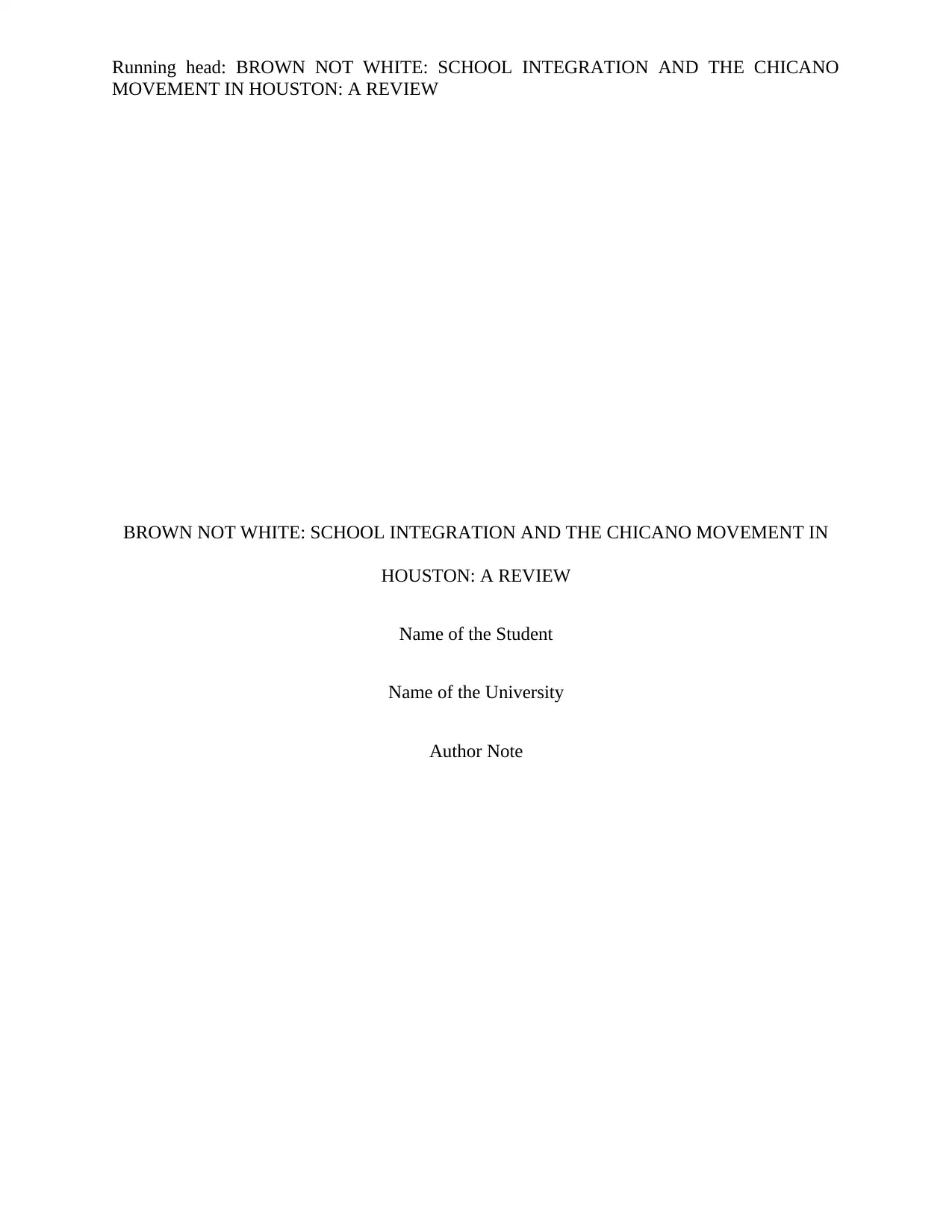
Running head: BROWN NOT WHITE: SCHOOL INTEGRATION AND THE CHICANO
MOVEMENT IN HOUSTON: A REVIEW
BROWN NOT WHITE: SCHOOL INTEGRATION AND THE CHICANO MOVEMENT IN
HOUSTON: A REVIEW
Name of the Student
Name of the University
Author Note
MOVEMENT IN HOUSTON: A REVIEW
BROWN NOT WHITE: SCHOOL INTEGRATION AND THE CHICANO MOVEMENT IN
HOUSTON: A REVIEW
Name of the Student
Name of the University
Author Note
Paraphrase This Document
Need a fresh take? Get an instant paraphrase of this document with our AI Paraphraser
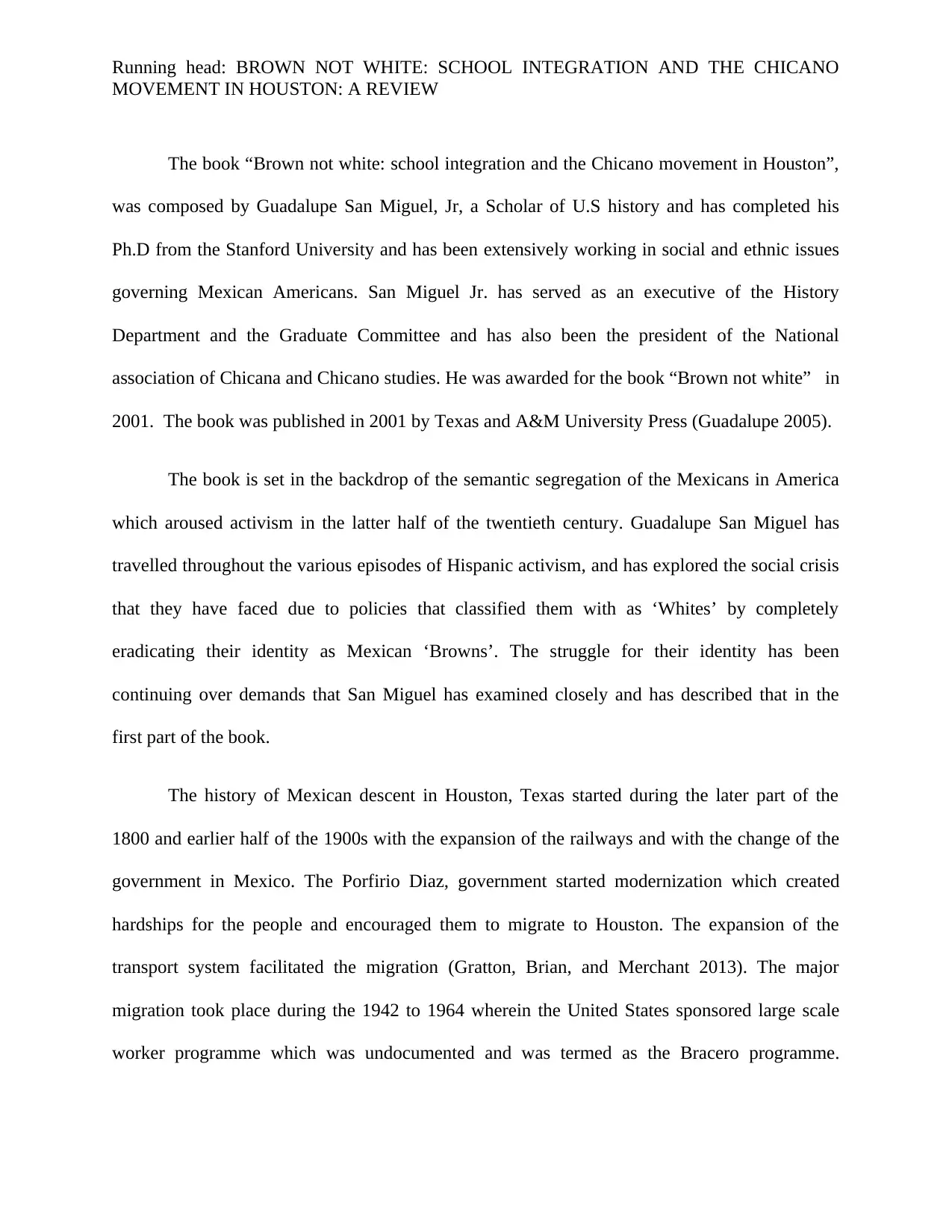
Running head: BROWN NOT WHITE: SCHOOL INTEGRATION AND THE CHICANO
MOVEMENT IN HOUSTON: A REVIEW
The book “Brown not white: school integration and the Chicano movement in Houston”,
was composed by Guadalupe San Miguel, Jr, a Scholar of U.S history and has completed his
Ph.D from the Stanford University and has been extensively working in social and ethnic issues
governing Mexican Americans. San Miguel Jr. has served as an executive of the History
Department and the Graduate Committee and has also been the president of the National
association of Chicana and Chicano studies. He was awarded for the book “Brown not white” in
2001. The book was published in 2001 by Texas and A&M University Press (Guadalupe 2005).
The book is set in the backdrop of the semantic segregation of the Mexicans in America
which aroused activism in the latter half of the twentieth century. Guadalupe San Miguel has
travelled throughout the various episodes of Hispanic activism, and has explored the social crisis
that they have faced due to policies that classified them with as ‘Whites’ by completely
eradicating their identity as Mexican ‘Browns’. The struggle for their identity has been
continuing over demands that San Miguel has examined closely and has described that in the
first part of the book.
The history of Mexican descent in Houston, Texas started during the later part of the
1800 and earlier half of the 1900s with the expansion of the railways and with the change of the
government in Mexico. The Porfirio Diaz, government started modernization which created
hardships for the people and encouraged them to migrate to Houston. The expansion of the
transport system facilitated the migration (Gratton, Brian, and Merchant 2013). The major
migration took place during the 1942 to 1964 wherein the United States sponsored large scale
worker programme which was undocumented and was termed as the Bracero programme.
MOVEMENT IN HOUSTON: A REVIEW
The book “Brown not white: school integration and the Chicano movement in Houston”,
was composed by Guadalupe San Miguel, Jr, a Scholar of U.S history and has completed his
Ph.D from the Stanford University and has been extensively working in social and ethnic issues
governing Mexican Americans. San Miguel Jr. has served as an executive of the History
Department and the Graduate Committee and has also been the president of the National
association of Chicana and Chicano studies. He was awarded for the book “Brown not white” in
2001. The book was published in 2001 by Texas and A&M University Press (Guadalupe 2005).
The book is set in the backdrop of the semantic segregation of the Mexicans in America
which aroused activism in the latter half of the twentieth century. Guadalupe San Miguel has
travelled throughout the various episodes of Hispanic activism, and has explored the social crisis
that they have faced due to policies that classified them with as ‘Whites’ by completely
eradicating their identity as Mexican ‘Browns’. The struggle for their identity has been
continuing over demands that San Miguel has examined closely and has described that in the
first part of the book.
The history of Mexican descent in Houston, Texas started during the later part of the
1800 and earlier half of the 1900s with the expansion of the railways and with the change of the
government in Mexico. The Porfirio Diaz, government started modernization which created
hardships for the people and encouraged them to migrate to Houston. The expansion of the
transport system facilitated the migration (Gratton, Brian, and Merchant 2013). The major
migration took place during the 1942 to 1964 wherein the United States sponsored large scale
worker programme which was undocumented and was termed as the Bracero programme.
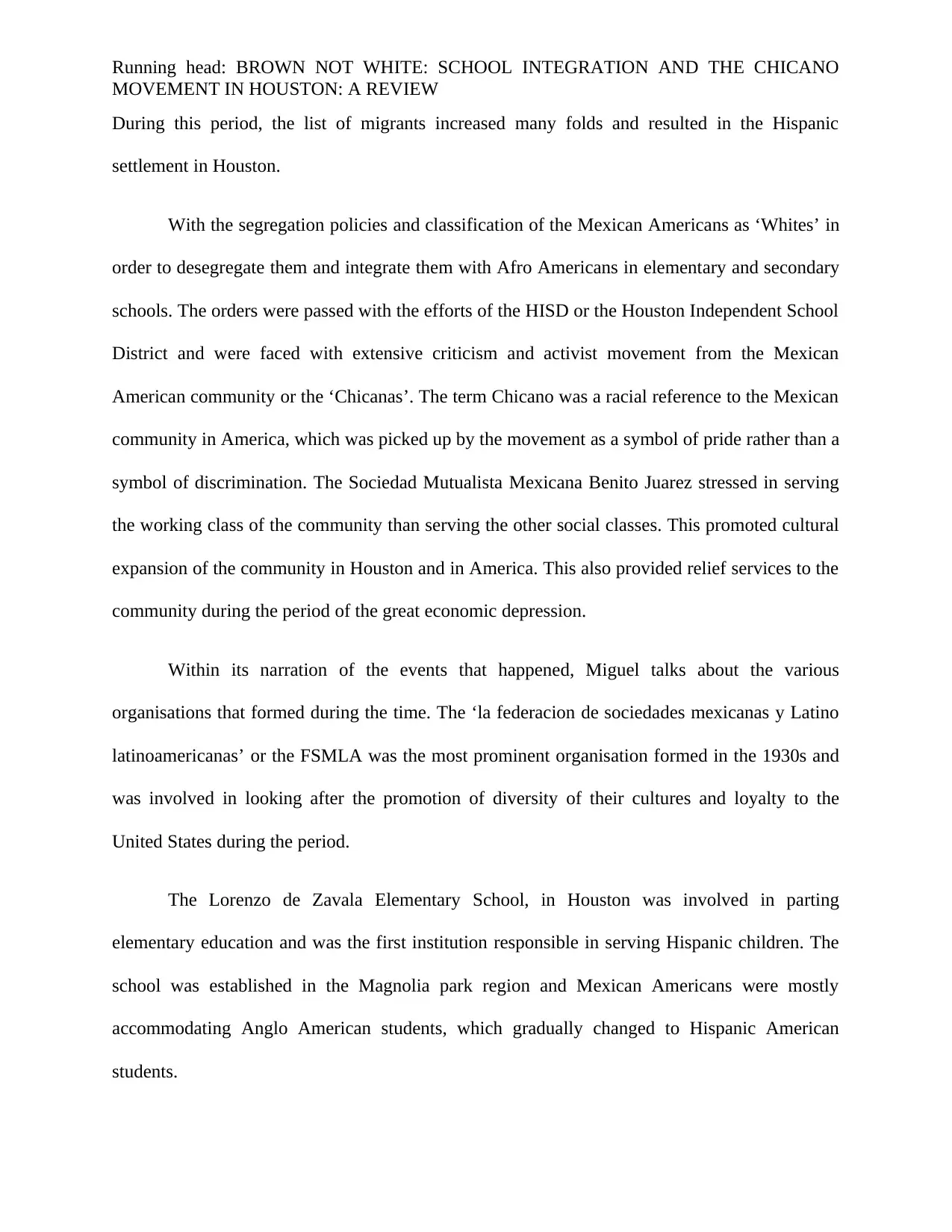
Running head: BROWN NOT WHITE: SCHOOL INTEGRATION AND THE CHICANO
MOVEMENT IN HOUSTON: A REVIEW
During this period, the list of migrants increased many folds and resulted in the Hispanic
settlement in Houston.
With the segregation policies and classification of the Mexican Americans as ‘Whites’ in
order to desegregate them and integrate them with Afro Americans in elementary and secondary
schools. The orders were passed with the efforts of the HISD or the Houston Independent School
District and were faced with extensive criticism and activist movement from the Mexican
American community or the ‘Chicanas’. The term Chicano was a racial reference to the Mexican
community in America, which was picked up by the movement as a symbol of pride rather than a
symbol of discrimination. The Sociedad Mutualista Mexicana Benito Juarez stressed in serving
the working class of the community than serving the other social classes. This promoted cultural
expansion of the community in Houston and in America. This also provided relief services to the
community during the period of the great economic depression.
Within its narration of the events that happened, Miguel talks about the various
organisations that formed during the time. The ‘la federacion de sociedades mexicanas y Latino
latinoamericanas’ or the FSMLA was the most prominent organisation formed in the 1930s and
was involved in looking after the promotion of diversity of their cultures and loyalty to the
United States during the period.
The Lorenzo de Zavala Elementary School, in Houston was involved in parting
elementary education and was the first institution responsible in serving Hispanic children. The
school was established in the Magnolia park region and Mexican Americans were mostly
accommodating Anglo American students, which gradually changed to Hispanic American
students.
MOVEMENT IN HOUSTON: A REVIEW
During this period, the list of migrants increased many folds and resulted in the Hispanic
settlement in Houston.
With the segregation policies and classification of the Mexican Americans as ‘Whites’ in
order to desegregate them and integrate them with Afro Americans in elementary and secondary
schools. The orders were passed with the efforts of the HISD or the Houston Independent School
District and were faced with extensive criticism and activist movement from the Mexican
American community or the ‘Chicanas’. The term Chicano was a racial reference to the Mexican
community in America, which was picked up by the movement as a symbol of pride rather than a
symbol of discrimination. The Sociedad Mutualista Mexicana Benito Juarez stressed in serving
the working class of the community than serving the other social classes. This promoted cultural
expansion of the community in Houston and in America. This also provided relief services to the
community during the period of the great economic depression.
Within its narration of the events that happened, Miguel talks about the various
organisations that formed during the time. The ‘la federacion de sociedades mexicanas y Latino
latinoamericanas’ or the FSMLA was the most prominent organisation formed in the 1930s and
was involved in looking after the promotion of diversity of their cultures and loyalty to the
United States during the period.
The Lorenzo de Zavala Elementary School, in Houston was involved in parting
elementary education and was the first institution responsible in serving Hispanic children. The
school was established in the Magnolia park region and Mexican Americans were mostly
accommodating Anglo American students, which gradually changed to Hispanic American
students.
⊘ This is a preview!⊘
Do you want full access?
Subscribe today to unlock all pages.

Trusted by 1+ million students worldwide
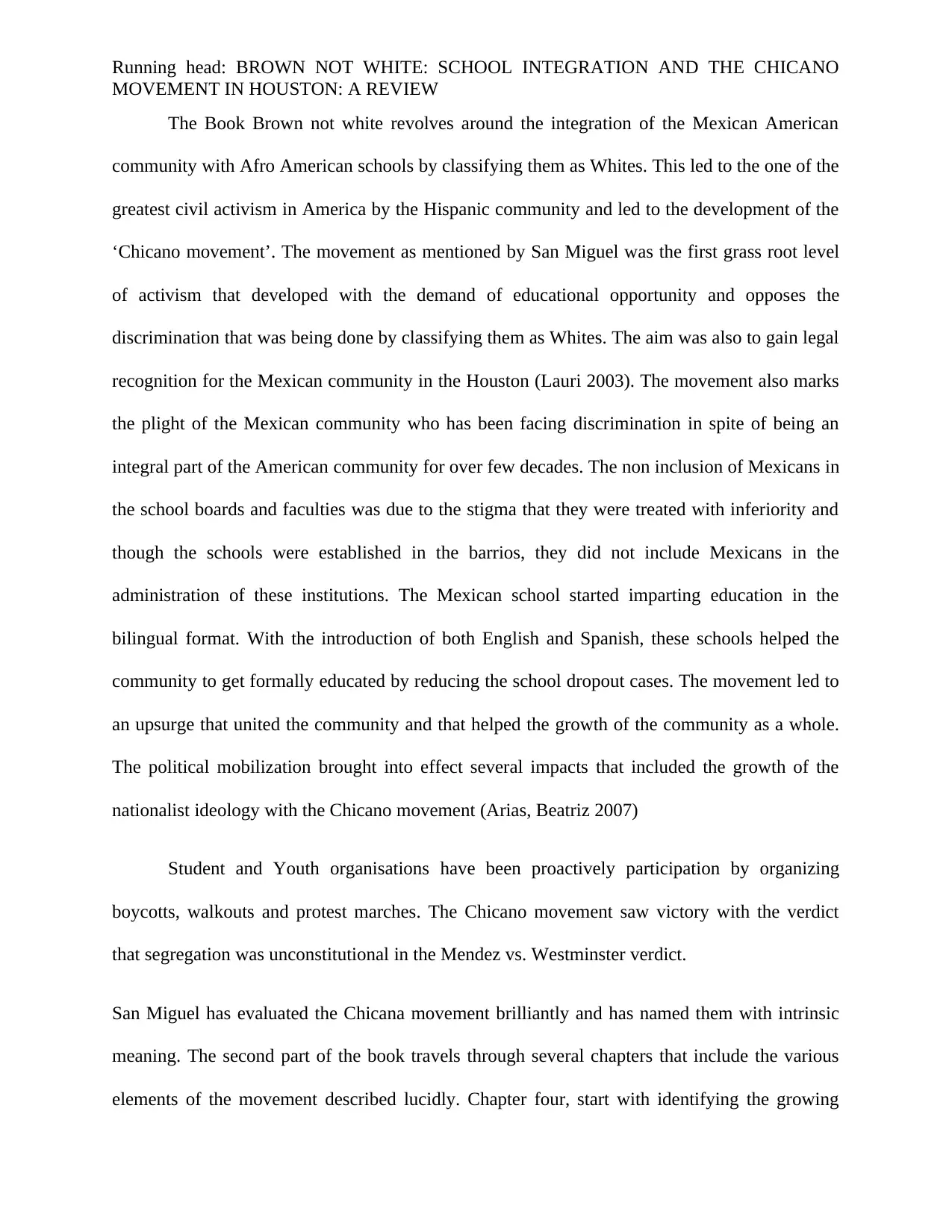
Running head: BROWN NOT WHITE: SCHOOL INTEGRATION AND THE CHICANO
MOVEMENT IN HOUSTON: A REVIEW
The Book Brown not white revolves around the integration of the Mexican American
community with Afro American schools by classifying them as Whites. This led to the one of the
greatest civil activism in America by the Hispanic community and led to the development of the
‘Chicano movement’. The movement as mentioned by San Miguel was the first grass root level
of activism that developed with the demand of educational opportunity and opposes the
discrimination that was being done by classifying them as Whites. The aim was also to gain legal
recognition for the Mexican community in the Houston (Lauri 2003). The movement also marks
the plight of the Mexican community who has been facing discrimination in spite of being an
integral part of the American community for over few decades. The non inclusion of Mexicans in
the school boards and faculties was due to the stigma that they were treated with inferiority and
though the schools were established in the barrios, they did not include Mexicans in the
administration of these institutions. The Mexican school started imparting education in the
bilingual format. With the introduction of both English and Spanish, these schools helped the
community to get formally educated by reducing the school dropout cases. The movement led to
an upsurge that united the community and that helped the growth of the community as a whole.
The political mobilization brought into effect several impacts that included the growth of the
nationalist ideology with the Chicano movement (Arias, Beatriz 2007)
Student and Youth organisations have been proactively participation by organizing
boycotts, walkouts and protest marches. The Chicano movement saw victory with the verdict
that segregation was unconstitutional in the Mendez vs. Westminster verdict.
San Miguel has evaluated the Chicana movement brilliantly and has named them with intrinsic
meaning. The second part of the book travels through several chapters that include the various
elements of the movement described lucidly. Chapter four, start with identifying the growing
MOVEMENT IN HOUSTON: A REVIEW
The Book Brown not white revolves around the integration of the Mexican American
community with Afro American schools by classifying them as Whites. This led to the one of the
greatest civil activism in America by the Hispanic community and led to the development of the
‘Chicano movement’. The movement as mentioned by San Miguel was the first grass root level
of activism that developed with the demand of educational opportunity and opposes the
discrimination that was being done by classifying them as Whites. The aim was also to gain legal
recognition for the Mexican community in the Houston (Lauri 2003). The movement also marks
the plight of the Mexican community who has been facing discrimination in spite of being an
integral part of the American community for over few decades. The non inclusion of Mexicans in
the school boards and faculties was due to the stigma that they were treated with inferiority and
though the schools were established in the barrios, they did not include Mexicans in the
administration of these institutions. The Mexican school started imparting education in the
bilingual format. With the introduction of both English and Spanish, these schools helped the
community to get formally educated by reducing the school dropout cases. The movement led to
an upsurge that united the community and that helped the growth of the community as a whole.
The political mobilization brought into effect several impacts that included the growth of the
nationalist ideology with the Chicano movement (Arias, Beatriz 2007)
Student and Youth organisations have been proactively participation by organizing
boycotts, walkouts and protest marches. The Chicano movement saw victory with the verdict
that segregation was unconstitutional in the Mendez vs. Westminster verdict.
San Miguel has evaluated the Chicana movement brilliantly and has named them with intrinsic
meaning. The second part of the book travels through several chapters that include the various
elements of the movement described lucidly. Chapter four, start with identifying the growing
Paraphrase This Document
Need a fresh take? Get an instant paraphrase of this document with our AI Paraphraser
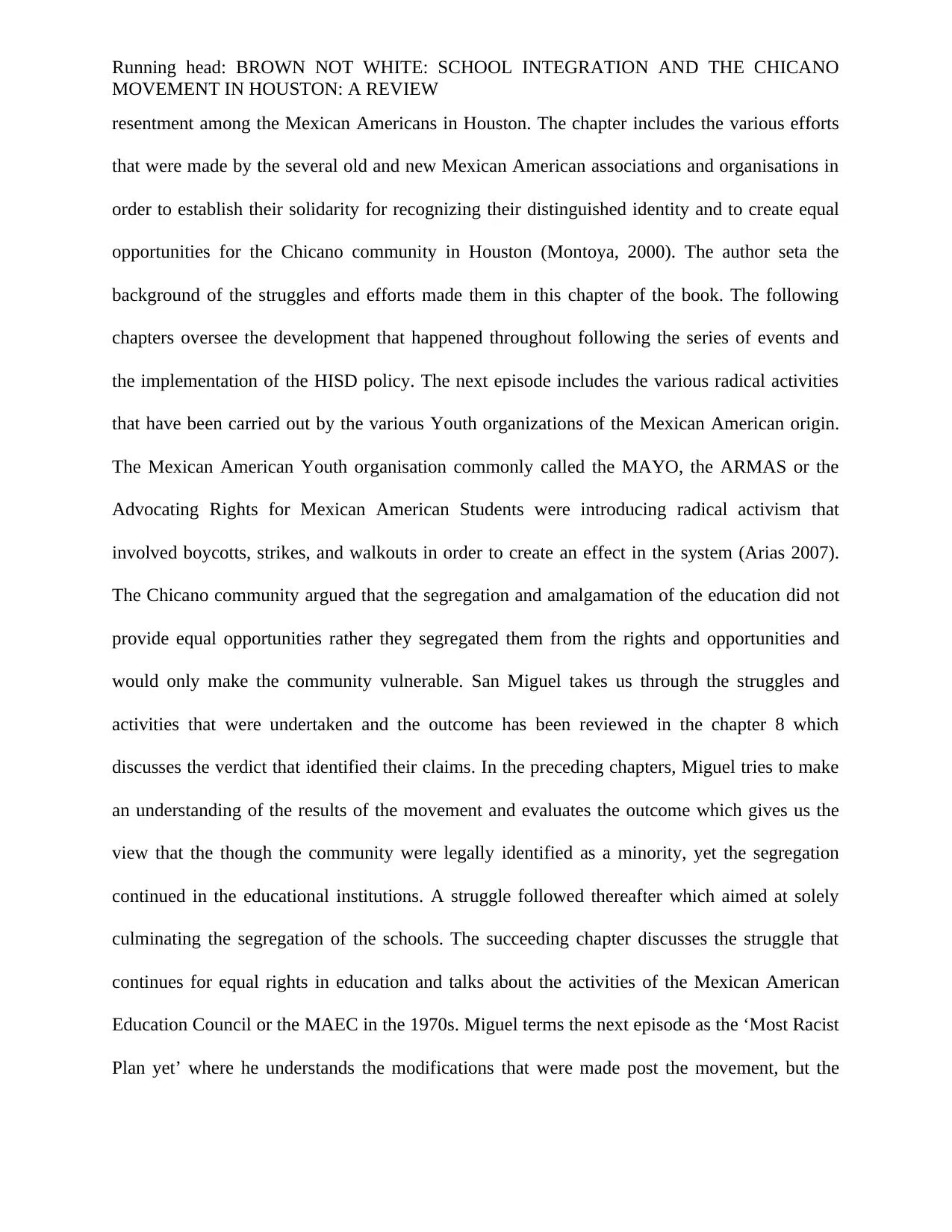
Running head: BROWN NOT WHITE: SCHOOL INTEGRATION AND THE CHICANO
MOVEMENT IN HOUSTON: A REVIEW
resentment among the Mexican Americans in Houston. The chapter includes the various efforts
that were made by the several old and new Mexican American associations and organisations in
order to establish their solidarity for recognizing their distinguished identity and to create equal
opportunities for the Chicano community in Houston (Montoya, 2000). The author seta the
background of the struggles and efforts made them in this chapter of the book. The following
chapters oversee the development that happened throughout following the series of events and
the implementation of the HISD policy. The next episode includes the various radical activities
that have been carried out by the various Youth organizations of the Mexican American origin.
The Mexican American Youth organisation commonly called the MAYO, the ARMAS or the
Advocating Rights for Mexican American Students were introducing radical activism that
involved boycotts, strikes, and walkouts in order to create an effect in the system (Arias 2007).
The Chicano community argued that the segregation and amalgamation of the education did not
provide equal opportunities rather they segregated them from the rights and opportunities and
would only make the community vulnerable. San Miguel takes us through the struggles and
activities that were undertaken and the outcome has been reviewed in the chapter 8 which
discusses the verdict that identified their claims. In the preceding chapters, Miguel tries to make
an understanding of the results of the movement and evaluates the outcome which gives us the
view that the though the community were legally identified as a minority, yet the segregation
continued in the educational institutions. A struggle followed thereafter which aimed at solely
culminating the segregation of the schools. The succeeding chapter discusses the struggle that
continues for equal rights in education and talks about the activities of the Mexican American
Education Council or the MAEC in the 1970s. Miguel terms the next episode as the ‘Most Racist
Plan yet’ where he understands the modifications that were made post the movement, but the
MOVEMENT IN HOUSTON: A REVIEW
resentment among the Mexican Americans in Houston. The chapter includes the various efforts
that were made by the several old and new Mexican American associations and organisations in
order to establish their solidarity for recognizing their distinguished identity and to create equal
opportunities for the Chicano community in Houston (Montoya, 2000). The author seta the
background of the struggles and efforts made them in this chapter of the book. The following
chapters oversee the development that happened throughout following the series of events and
the implementation of the HISD policy. The next episode includes the various radical activities
that have been carried out by the various Youth organizations of the Mexican American origin.
The Mexican American Youth organisation commonly called the MAYO, the ARMAS or the
Advocating Rights for Mexican American Students were introducing radical activism that
involved boycotts, strikes, and walkouts in order to create an effect in the system (Arias 2007).
The Chicano community argued that the segregation and amalgamation of the education did not
provide equal opportunities rather they segregated them from the rights and opportunities and
would only make the community vulnerable. San Miguel takes us through the struggles and
activities that were undertaken and the outcome has been reviewed in the chapter 8 which
discusses the verdict that identified their claims. In the preceding chapters, Miguel tries to make
an understanding of the results of the movement and evaluates the outcome which gives us the
view that the though the community were legally identified as a minority, yet the segregation
continued in the educational institutions. A struggle followed thereafter which aimed at solely
culminating the segregation of the schools. The succeeding chapter discusses the struggle that
continues for equal rights in education and talks about the activities of the Mexican American
Education Council or the MAEC in the 1970s. Miguel terms the next episode as the ‘Most Racist
Plan yet’ where he understands the modifications that were made post the movement, but the
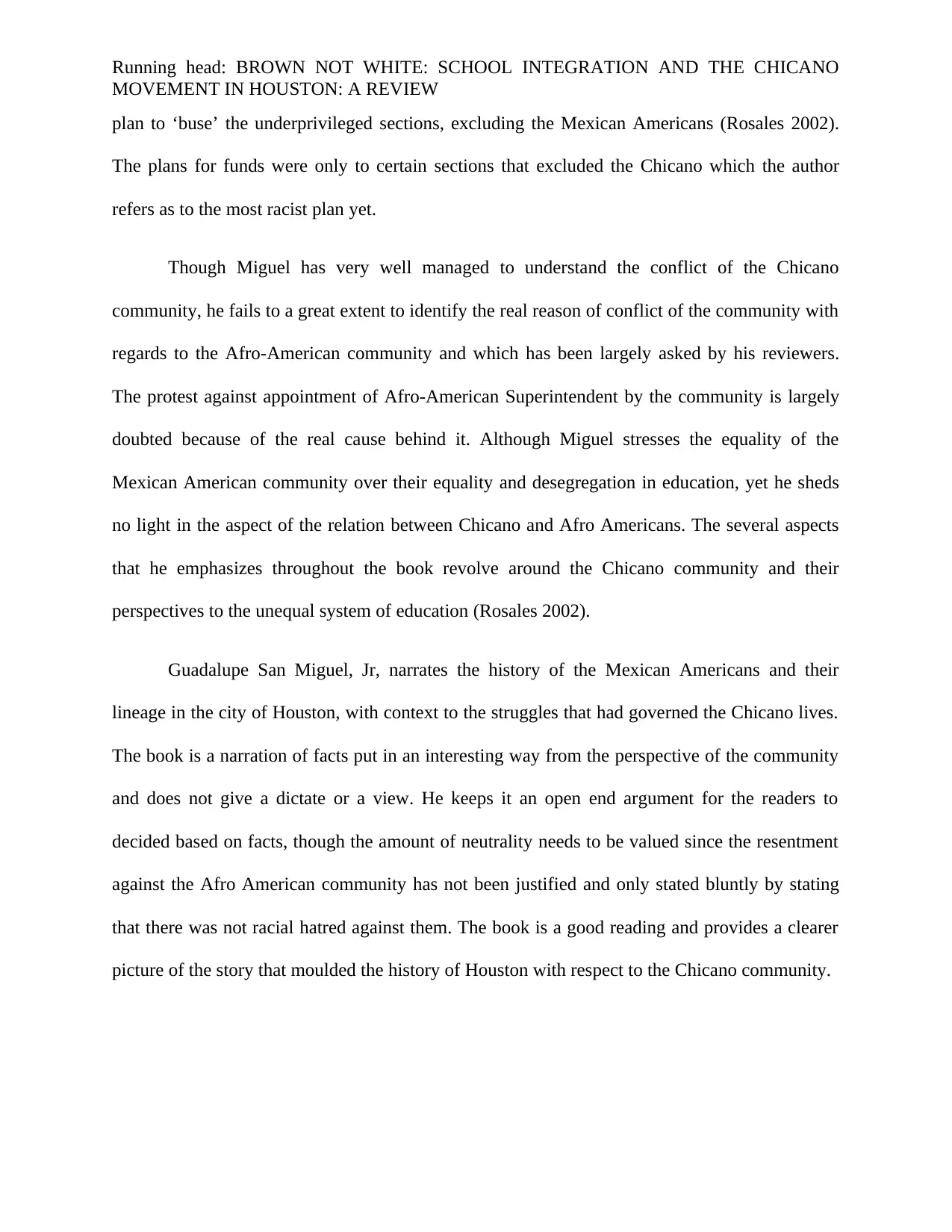
Running head: BROWN NOT WHITE: SCHOOL INTEGRATION AND THE CHICANO
MOVEMENT IN HOUSTON: A REVIEW
plan to ‘buse’ the underprivileged sections, excluding the Mexican Americans (Rosales 2002).
The plans for funds were only to certain sections that excluded the Chicano which the author
refers as to the most racist plan yet.
Though Miguel has very well managed to understand the conflict of the Chicano
community, he fails to a great extent to identify the real reason of conflict of the community with
regards to the Afro-American community and which has been largely asked by his reviewers.
The protest against appointment of Afro-American Superintendent by the community is largely
doubted because of the real cause behind it. Although Miguel stresses the equality of the
Mexican American community over their equality and desegregation in education, yet he sheds
no light in the aspect of the relation between Chicano and Afro Americans. The several aspects
that he emphasizes throughout the book revolve around the Chicano community and their
perspectives to the unequal system of education (Rosales 2002).
Guadalupe San Miguel, Jr, narrates the history of the Mexican Americans and their
lineage in the city of Houston, with context to the struggles that had governed the Chicano lives.
The book is a narration of facts put in an interesting way from the perspective of the community
and does not give a dictate or a view. He keeps it an open end argument for the readers to
decided based on facts, though the amount of neutrality needs to be valued since the resentment
against the Afro American community has not been justified and only stated bluntly by stating
that there was not racial hatred against them. The book is a good reading and provides a clearer
picture of the story that moulded the history of Houston with respect to the Chicano community.
MOVEMENT IN HOUSTON: A REVIEW
plan to ‘buse’ the underprivileged sections, excluding the Mexican Americans (Rosales 2002).
The plans for funds were only to certain sections that excluded the Chicano which the author
refers as to the most racist plan yet.
Though Miguel has very well managed to understand the conflict of the Chicano
community, he fails to a great extent to identify the real reason of conflict of the community with
regards to the Afro-American community and which has been largely asked by his reviewers.
The protest against appointment of Afro-American Superintendent by the community is largely
doubted because of the real cause behind it. Although Miguel stresses the equality of the
Mexican American community over their equality and desegregation in education, yet he sheds
no light in the aspect of the relation between Chicano and Afro Americans. The several aspects
that he emphasizes throughout the book revolve around the Chicano community and their
perspectives to the unequal system of education (Rosales 2002).
Guadalupe San Miguel, Jr, narrates the history of the Mexican Americans and their
lineage in the city of Houston, with context to the struggles that had governed the Chicano lives.
The book is a narration of facts put in an interesting way from the perspective of the community
and does not give a dictate or a view. He keeps it an open end argument for the readers to
decided based on facts, though the amount of neutrality needs to be valued since the resentment
against the Afro American community has not been justified and only stated bluntly by stating
that there was not racial hatred against them. The book is a good reading and provides a clearer
picture of the story that moulded the history of Houston with respect to the Chicano community.
⊘ This is a preview!⊘
Do you want full access?
Subscribe today to unlock all pages.

Trusted by 1+ million students worldwide
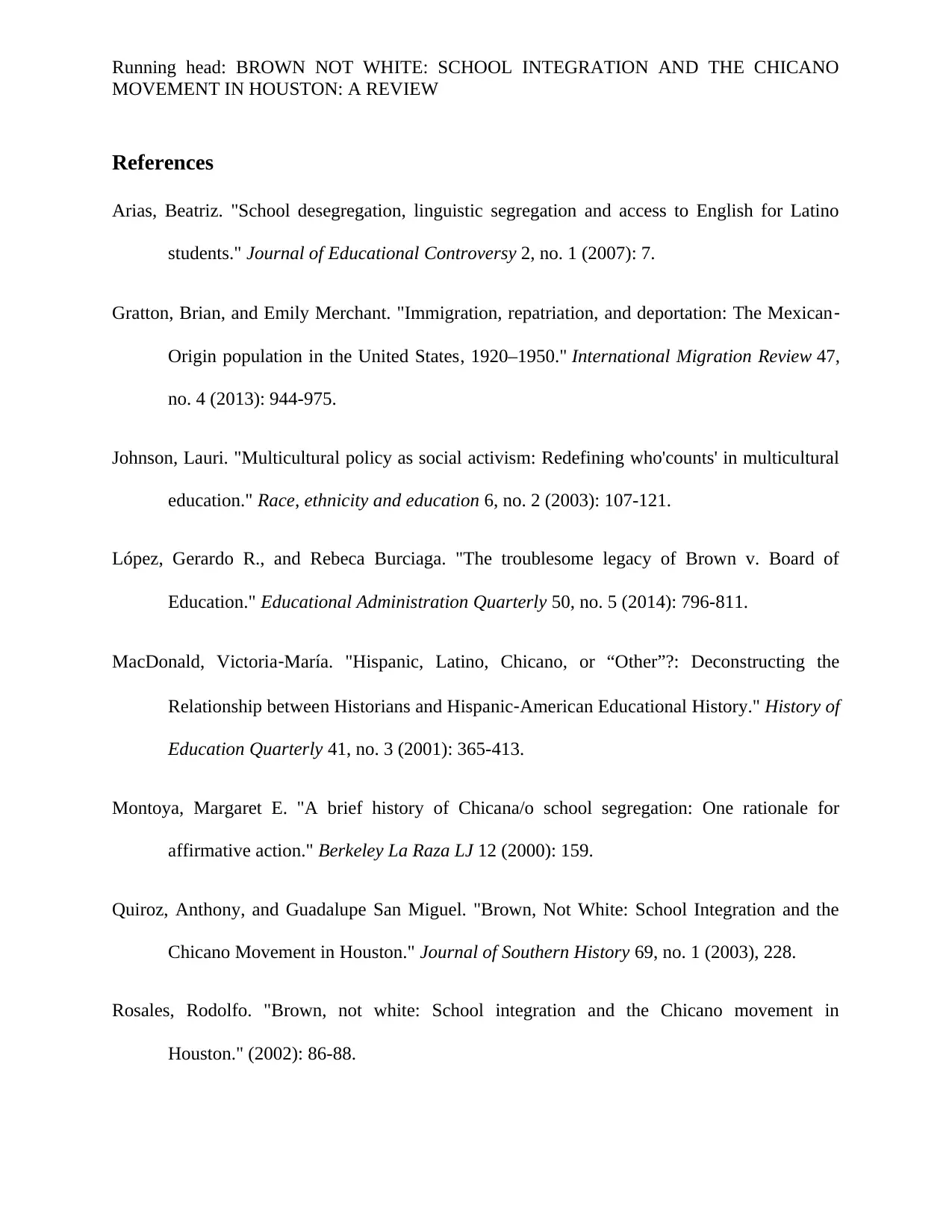
Running head: BROWN NOT WHITE: SCHOOL INTEGRATION AND THE CHICANO
MOVEMENT IN HOUSTON: A REVIEW
References
Arias, Beatriz. "School desegregation, linguistic segregation and access to English for Latino
students." Journal of Educational Controversy 2, no. 1 (2007): 7.
Gratton, Brian, and Emily Merchant. "Immigration, repatriation, and deportation: The Mexican‐
Origin population in the United States, 1920–1950." International Migration Review 47,
no. 4 (2013): 944-975.
Johnson, Lauri. "Multicultural policy as social activism: Redefining who'counts' in multicultural
education." Race, ethnicity and education 6, no. 2 (2003): 107-121.
López, Gerardo R., and Rebeca Burciaga. "The troublesome legacy of Brown v. Board of
Education." Educational Administration Quarterly 50, no. 5 (2014): 796-811.
MacDonald, Victoria‐María. "Hispanic, Latino, Chicano, or “Other”?: Deconstructing the
Relationship between Historians and Hispanic‐American Educational History." History of
Education Quarterly 41, no. 3 (2001): 365-413.
Montoya, Margaret E. "A brief history of Chicana/o school segregation: One rationale for
affirmative action." Berkeley La Raza LJ 12 (2000): 159.
Quiroz, Anthony, and Guadalupe San Miguel. "Brown, Not White: School Integration and the
Chicano Movement in Houston." Journal of Southern History 69, no. 1 (2003), 228.
Rosales, Rodolfo. "Brown, not white: School integration and the Chicano movement in
Houston." (2002): 86-88.
MOVEMENT IN HOUSTON: A REVIEW
References
Arias, Beatriz. "School desegregation, linguistic segregation and access to English for Latino
students." Journal of Educational Controversy 2, no. 1 (2007): 7.
Gratton, Brian, and Emily Merchant. "Immigration, repatriation, and deportation: The Mexican‐
Origin population in the United States, 1920–1950." International Migration Review 47,
no. 4 (2013): 944-975.
Johnson, Lauri. "Multicultural policy as social activism: Redefining who'counts' in multicultural
education." Race, ethnicity and education 6, no. 2 (2003): 107-121.
López, Gerardo R., and Rebeca Burciaga. "The troublesome legacy of Brown v. Board of
Education." Educational Administration Quarterly 50, no. 5 (2014): 796-811.
MacDonald, Victoria‐María. "Hispanic, Latino, Chicano, or “Other”?: Deconstructing the
Relationship between Historians and Hispanic‐American Educational History." History of
Education Quarterly 41, no. 3 (2001): 365-413.
Montoya, Margaret E. "A brief history of Chicana/o school segregation: One rationale for
affirmative action." Berkeley La Raza LJ 12 (2000): 159.
Quiroz, Anthony, and Guadalupe San Miguel. "Brown, Not White: School Integration and the
Chicano Movement in Houston." Journal of Southern History 69, no. 1 (2003), 228.
Rosales, Rodolfo. "Brown, not white: School integration and the Chicano movement in
Houston." (2002): 86-88.
Paraphrase This Document
Need a fresh take? Get an instant paraphrase of this document with our AI Paraphraser
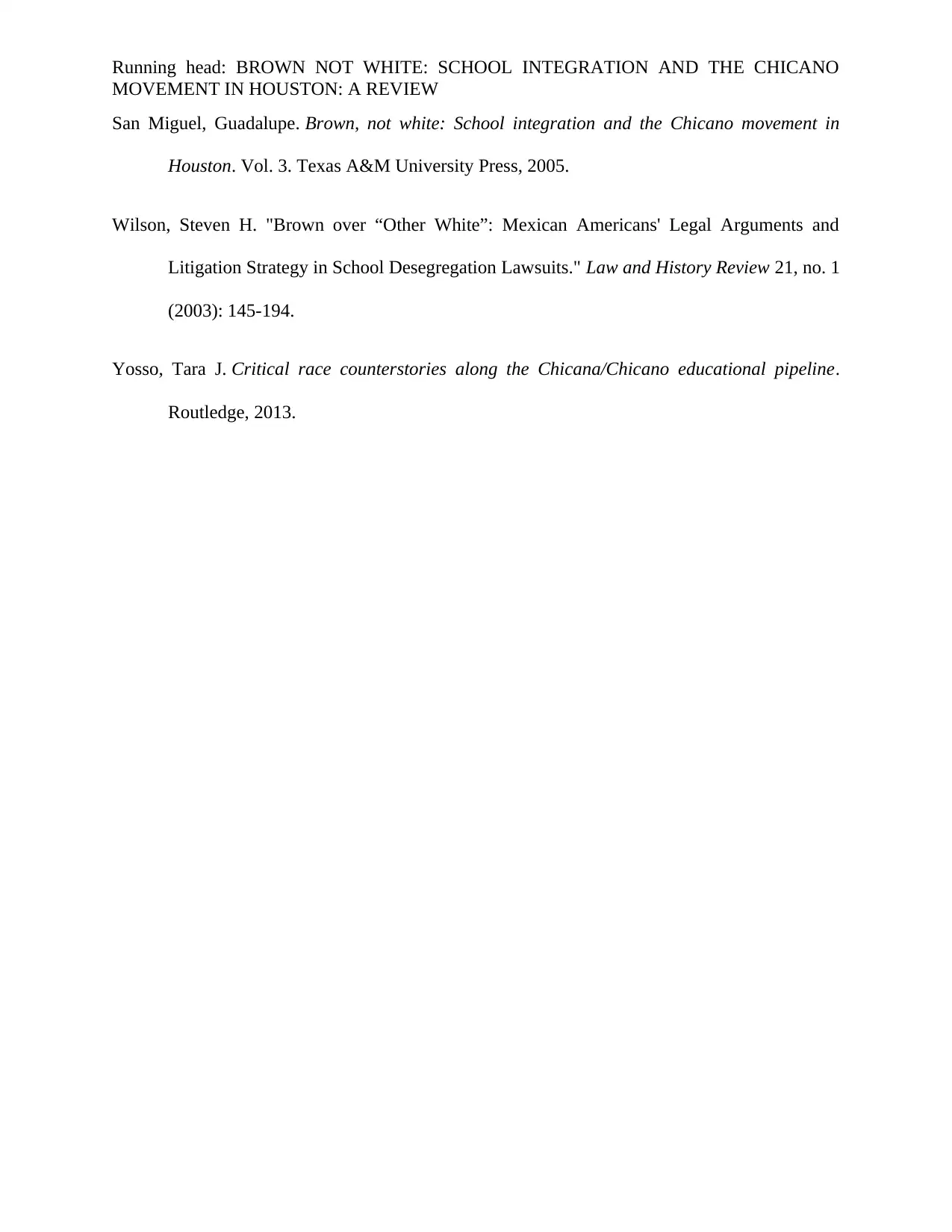
Running head: BROWN NOT WHITE: SCHOOL INTEGRATION AND THE CHICANO
MOVEMENT IN HOUSTON: A REVIEW
San Miguel, Guadalupe. Brown, not white: School integration and the Chicano movement in
Houston. Vol. 3. Texas A&M University Press, 2005.
Wilson, Steven H. "Brown over “Other White”: Mexican Americans' Legal Arguments and
Litigation Strategy in School Desegregation Lawsuits." Law and History Review 21, no. 1
(2003): 145-194.
Yosso, Tara J. Critical race counterstories along the Chicana/Chicano educational pipeline.
Routledge, 2013.
MOVEMENT IN HOUSTON: A REVIEW
San Miguel, Guadalupe. Brown, not white: School integration and the Chicano movement in
Houston. Vol. 3. Texas A&M University Press, 2005.
Wilson, Steven H. "Brown over “Other White”: Mexican Americans' Legal Arguments and
Litigation Strategy in School Desegregation Lawsuits." Law and History Review 21, no. 1
(2003): 145-194.
Yosso, Tara J. Critical race counterstories along the Chicana/Chicano educational pipeline.
Routledge, 2013.
1 out of 8
Your All-in-One AI-Powered Toolkit for Academic Success.
+13062052269
info@desklib.com
Available 24*7 on WhatsApp / Email
![[object Object]](/_next/static/media/star-bottom.7253800d.svg)
Unlock your academic potential
Copyright © 2020–2025 A2Z Services. All Rights Reserved. Developed and managed by ZUCOL.